
Selected Essays on Aeromodelling Updated January 1, 2004
Modelling and Aeromodelling
Fine Art ModelsRadio Control
Nicola Tesla : Inventor of Wireless Radio Control, 1893 Modelling and AeromodellingFine Art Models http://www.fineartmodels.com Models, or rather miniatures, have been made by man ever since he learned to stand upright-in the very beginning as objects of religion, and then as presents for decoration. In those early days, materials used were bone, stone, or rock and wood-materials readily available. Tools were crude in the extreme, so the results were crude. Accuracy of representation developed as man's skill to invent and use tools and new materials grew, and this trend continues to the present day. By the 14th and 15th centuries, these skills had developed to an extraordinary degree as can be seen in full-size artifacts and miniatures made by armorers and instrument makers. The majority of models, however, were still rather crude-mostly ships, the "votif" models made to hang in churches by way of thanksgiving for journey's end and a safe return. As they were intended to be hung and, therefore, seen only from underneath, guns are exaggerated, hull shapes simple, deck fittings almost nonexistent and rigging inaccurate. By the 17th and 18th centuries, standards of faithfulness to prototype had changed dramatically as, for example, the model ships built for the Navy Board. These were built by the finest craftsmen, mostly of box and fruitwood as three- dimensional pictures of proposals for future ships so My Lords of the Admiralty were better able to judge design. These models were incredibly accurate in shape and details, and many have survived, being in museums and private collections around the world. They are important, not only as a record of ship design during the period, but as the first truly accurate models. During the 19th century, with the coming of the Industrial Revolution, three-dimensional miniatures were made for different reasons-steam, the motif power at that time, is very powerful and, logically, a small machine, if it is going to explode, will make less of a bang than the full-size machine. Many development models were made, mainly by instrument makers and then by that rapidly developing genre-the engineer. As the 19th century progressed, on one hand the making of a model became part of an apprentice engineer's life-his test piece had to be of a very high standard to pass. On the other hand the salesman needed a model for the same practical reason as did My Lords of the Admiralty, all those years before. About this time, miniatures began to be made, originally by those self-same apprentices-now fully fledged engineers-for fun in their leisure hours, and thus was born amateur model-making as we now know it. In parallel, there were commercial organizations making models, kits and toys, as for example, Stevens Model Dockyard, Basset-Lowke and many others, all trying to satisfy an insatiable desire by man to own miniatures of things he wished to remember for one reason or another. Models have, however, been made for entirely different and particular purposes; e.g., the bone model ships may by French prisoners of war in England between about 1775 and 1815 (they were made to supplement their rations), or Patent Models made as part of the inventive process. These fall outside the mainstream of model making, but are historically important in their own right. Now at the end of the 20th century, a different problem has arisen. The commercially trained skills of apprenticed engineers are gradually dying out as man's quest toward computerization develops, and discerning collectors, who understand and seek quality, generally have neither the time nor skill to make aesthetically pleasing and ever more accurate miniatures themselves. Fine Art Models now fills this role using the best craftsmen available anywhere in the world to create the finest quality short production runs of ships, locomotives, airplanes, and road vehicles that have ever been available. They are, of course, built for decorative purposes and so, in a way, the wheel has turned full circle. Long may serious and discerning collectors exist who demand the best; satisfying their demands will preserve and continue the necessary skills, which will otherwise, gradually, be lost forever.
Tom Rose, Director, Christie's South Kensington, London, England
Chapter 1 The history of aircraft modeling is closely linked with the history of aviation. Early experimenters often tested their ideas with models rather than risking their lives and fortunes with full sized aircraft. It's interesting to note the cause and effect that the two fields of interest have on one another. In 1871 a young Frenchman, Alphonse Penaud, flew his famous Planophore. This was a rubber-powered pusher model. His best-recorded flight was 131 feet. He also made model helicopters, one of which hovered for 26 seconds. When United Brethren Bishop Milton Wright bought his sons a small toy flying machine, the boys were intrigued. They tried unsuccessfully to duplicate it with larger models. It was their first thinking, Orville admitted, about anything to do with flying machines. By the way, the toy was one of Penaud's helicopters. The public perception that all model aircraft are toys has always been a problem. The late head of the Smithsonian Institution, Professor Samuel Pierpont Langley's 1901 gas powered model weighed 58 pounds. He was discouraged from flying it because some small-minded men, whose names are fittingly lost to us, chided the head of so illustrious an institution for fussing with toy airplanes. [1982 Model Airplane News Annual, 42] In 1908 an enterprising 15-year-old designed a rubber-powered model, patented it, and registered its trademark "Ayrel." It was a huge success, firmly establishing him in the design and manufacturing business. His name was Raymond Loewy, famed industrial designer. In 1915, the Detroit Society of Automotive Engineers asked William B. Stout to speak on aviation at its annual banquet. To enliven his talk, he took four boys with him from the Chicago Model Club. They flew their model airplanes out over the audience. The last model, a flying boat, took off from a big meat platter filled with water that had been placed on the speaker's table, and flew the length of the room. Just twelve years after the Wright brothers flew at Kitty Hawk an established model airplane club had entertained the prestigious Society of Automotive Engineers. [Frank Zaic, Model Airplanes and the American Boy Northridge, CA: Model Aeronautic Publications, 1982, 158]. During the 1920s a model design called a Twin Pusher was popular. It had an A-frame fuselage and rubber bands powered its twin propellers. For more on the Twin Pusher see: home.att.net/~dannysoar/home.htm. During the formative years of aviation various organizations, and alliances of these organizations with industry, served to educate and represent their members. The Federation Aeronautique Internationale (FAI) was founded in 1905. Representatives from France, Germany and Belgium proposed a federation to the Olympic Congress of Brussels. The proposal was well received and an international conference was convened in Paris. Representatives of Belgium, France, Germany, Great Britain, Italy, Spain, Switzerland, and the United States agreed to a package of statutes. The aims of the FAI were, and are, to "methodically catalog the best performances achieved, so that they be known to everybody; to identify their distinguishing features so as to permit comparisons to be made; and to verify evidence and thus ensure that record-holders have undisputed claims to their titles." They also specified that each national member should retain full and autonomous control over its own affairs. www.fai.org/about/ The Aero Club of America was formed in the summer of 1905 by a group of automobile enthusiasts interested in mankind's future in the air. The club was patterned after the Aero-Club de France, with the objective of promoting the"development of aerial navigation." [Tom Crouch, The Bishop's Boys, W. W. Norton, N.Y., 312]. The National Aeronautic Association (NAA) traces its roots back to 1905 when the Aero Club of America was founded. The NAA was incorporated in 1922 and was the first to issue pilot licenses. Original members include Wilbur and Orville Wright, Charles Lindbergh, Jimmie Doolittle, and many others of note. www.naa-usa.org/website and click welcome. In time the NAA was to play an important role in Model Aviation. It was William B. Stout who founded the Airplane Model League of America (AMLA). Stout wrote model building articles in 1916 for the American Boy magazine. Merrill Hamburg, who worked with Stout, became American Boy's model airplane editor in 1927 and the magazine carried a series of model plane construction articles through 1934 as part of the AMLA program. At its peak AMLA had 400,000 members. Frank Zaic has reprinted these articles under the title, Model Airplanes and the American Boy 1927-1934. Zaic also published other important annual books. These yearbooks published from 1934 to 1938 contain drawings and comment about significant models during the year. They are time capsules of a golden age of model aviation. These and other Zaic books are available from the Academy of Model Aeronautics or distributors such as Hannan's Runway. www.hrunway.com. In 1928 the NAA designated the American Boy to conduct the indoor and outdoor national contests at Detroit. The AMLA phased out in 1934, and NAA took charge of the 1935 national contest for its junior members. During this period aviator Roscoe Turner joined with William R. Hearst and his newspapers to create the Junior Birdmen of America, which became the official NAA committee on model aviation. The magazine Model Airplane News published NAA Junior Membership news along with that of the International Gas Model Airplane Association (IGMAA). The IGMAA was formed to unify opposition to an effort being made by states to outlaw the use of gas model engines. In 1938 IGMAA membership was turned over to the newly formed Academy of Model Aeronautics and the current organizational structure was in place. About this time an established organization called Air Youth of America published a book that provided guidance to those who wished to conduct model aircraft competitions. [Model Airplane Contests, An Air Youth Guide with Official Rules, New York: D. Appelton-Century Company, 1940]. The book had descriptions of "informal contests" featuring five models of Air Youth's own design. This was followed by "rules for formal or sanctioned contests." These were rules for "the sport of flying model aircraft" and, it stated further about the formal rules, "rules governing it for the United States have been established by the National Aeronautic Association through the Academy of Model Aeronautics". This Air Youth book credits many sources and individuals for "help in the preparation of this guide." Individuals mentioned reads like a who's who of early model aviation. Charles Grant, editor of Model Airplane News, Walter M. Hall, Boys' Club of America, Al Lewis. Secretary of Academy of Model Aeronautics, Irwin Polk, vice-president, Academy of Model Aeronautics, and many other notables. The Air Youth of America published another book [Building and Flying Model Airplanes, An Air Youth Handbook, New York: D. Appleton-Century company, 1943] that described, in great detail, the process of constructing a model airplane. Much of the material presented is still applicable today. Although the AMA was incorporated in 1938, its current monthly publication, Model Aviation, was first published as "the official publication of the American Academy for Model Aeronautics" in New York City in June, 1936". It was "devoted to news reports and papers on experimental, theoretical, and applied science as employed in model aeronautics." Impressive goals. More on the role of AMA and its special interest groups in Chapter 3. An event occurred in the 1930s that underscores the importance of model building to national defense. In 1915 the National Advisory Committee for Aeronautics (NACA) was established. Its charter was "to supervise and direct the scientific study of the problems of flight with a view to their practical solution, and to direct and conduct experiments in aerodynamics." The course of world events leading up to World War 2 resulted in a major expansion of NACA's facilities, including those at Langley Field in Virginia. Dr. Edward R. Sharp of NACA took a special interest in model builders. He saw them as a "pool" of employees for NACA. He established a program, and had it placed on the U. S. Civil Service Register, as Under Aircraft Modelmaker around 1939. Leading up to the war NACA was rushing completion of better and faster wind tunnels. They required huge laminated wooden propellers. Pattern making was the closest trade applicable to this project. NACA found that not one patternmaking application was on file with the Civil Service Commission. For the first time in the history of the Civil Service Commission Doctor Sharp convinced them to set up a civil service job classification for any person who had successfully built and flown model airplanes and entered them in formal competition with others. NACA was flooded with applications. The man in charge of the wind tunnel propeller project was told he would have no grown men, only those young boy modelers to work for him. They got the job done, and when NACA management saw the propeller problem solved they immediately started placing these boys in just about every important job underway at the laboratory. This led to starting the NACA Apprentice Administration. The AMA cooperated in recruiting the Under Aircraft Modelmakers. NACA noted that "the vast importance of AMA's program of fostering and encouraging model building is clearly demonstrated in the performance of these modelmakers in our defense effort." [Model Aviation magazine, March, 1999, 5] Many of those AMLA and AMA members went on to serve their country in the Air Forces during World War 2. The scenario has been repeated in the 1990s when hobbyists experienced in building and guiding radio controlled models contributed to the training of ground based pilots of radio controlled reconnaissance drones found so effective in Operation Desert Storm. See www.aerovironment.com/area-aircraft/unmanned.html for recent developments in unmanned aerial vehicles. Page 2 of this site contains a link to "a paper on the Black Widow's development." This outlines dramatic miniaturization of electronic components that benefit radio controlled model aviation. It is interesting to note that astronaut John Glenn built model airplanes as a boy, as have many others prominent in the field of aviation. Aircraft designer Burt Rutan, creator of many innovative designs including the first aircraft to fly around the world non-stop, was an active modeler. See his corporate Web site for photos of his latest creations. www.scaled.com/
En 1870, Alphonse PENAUD présente à la société Française de Navigation Aérienne un petit "automoteur" mû par la force de distorsion d'une ou plusieurs lanières de caoutchouc préalablement tordues sur elles-mêmes. Le 18 août 1871, le même Alphonse PENAUD présente au Jardin des Tuileries à Paris, son aéroplane qu'il appelle le "Planophore". L'aéromodélisme devient alors un puissant moyen de diffusion aéronautique. En août 1909, la revue "'L'AUTO" faisait disputer au Parc des Princes à Paris, la coupe "GORDON-BENNET" des petits aéroplanes. De grands pilotes s'intéressent aussi à l'aéromodélisme : Louis Paulman, Maurice Arnoux ainsi que Jules Vedrines et de nombreux Clubs commencent à voir le jour. Le 26 septembre 1920, l'Association Française Aérienne organise à Vincennes, un concours qui réunit de très nombreux concurrents. Le ministre de l'Air Pierre COT crée le Comité Français des Modèles Réduits. Les 7 et 8 mai 1938 a lieu le premier "Congrès National des Aéromodélistes". En 1946, la Ligue Française de l'Enseignement crée le "Cercle Laïque d'Aviation Populaire" (CLAP), et dans le même temps, la "Fédération Nationale Aéronautique" (FNA) avec l'Aéro Club de France créent une Commission Modéliste. En 1950, au cours du 5ème congrès de la Fédération Nationale Aéronautique (FNA), les aéromodélistes obtiennent un grande représentativité au sein des Conseils d'Administration et des Aéro Clubs. Et le 16 janvier 1966, la "Fédération Française d'Aéro-Modélisme" (FFAM) est créée avec Monsieur Jean Moretti comme Président et Monsieur Jean Ganier au poste de Directeur.
Micro radio-control aircraft make this once-cumbersome hobby fun and practical. by Don Ross and Gabe Baltaian Imagine a silent, slow-moving model airplane small enough to fit in a shoebox, yet capable of performing aerobatic maneuvers in a space the size of a school gym. No, we're not asking you to envision secret government spy eyes built at a cost of millions. We're talking about Almost Ready to Fly (ARF) kits that cross the line between toys and a high-tech hobby. Model airplanes easily pre-date the Wright brothers. Airplane pioneer Samuel Langley flew a steam-powered model across the Potomac River well before the Wrights' Kitty Hawk flight. Rubber band-powered planes were fascinating hobbyists at the turn of the 20th century. And, many of today's modelers started making spotter models to help U.S. Navy pilots identify enemy planes during World War II. The first radio-control (RC) models were behemoths, with 10- to 12-ft. wingspans and weights of several pounds. These proportions were necessary to lift the heavy radio equipment, which at that time contained vacuum tubes and dry-cell batteries. Control was chancy and intermittent, with noisy engines running and at wide-open throttle most of the time. Sometimes, these planes evaded control and had to be chased by car for miles before being recovered-others were lost forever. By the late 1960s, smaller radios had been created and electric motors appeared. Through the 1980s, motors became more powerful and rechargeable batteries came on the scene, allowing for longer, safer flights. The heavy large-span models began to shrink, and huge air fields were no longer necessary to accomodate them. Noisy, smelly gas engines were replaced by almost silent, smooth-starting electric motors, much to the relief of people who lived within earshot of the fields. Many kit and toy manufacturers noticed this trend and began to supply both kits and ARF models. Now, ARFs are available in a variety of prebuilt levels. Some have covered frames, some are made of foam that doesn't require a covering. These kits need only simple assembly and radio installation. Others have a ready-made framework that you cover with heat-activated, rugged plastic sheeting. The new "instant" cyanoacrilate glues on the market nearly eliminate drying time during assembly, and laser cutting of parts has made them glitchfree. Many of these kit products are imported from Japan, China and Europe and fly almost as well as the hand-built versions of the past. Proportional radio receivers with four channels and speed control are available for about $100. These receivers respond to the proportional motion of the control stick rather than to just On and Off signals, and some weigh as little as 4 grams (less than an ounce). A system called Battery Eliminator Circuit (BEC) allows both the radio and the plane's servo motors to be powered by the same battery. The circuit senses battery voltage and cuts off power to the motors when the voltage drops to a predetermined level-leaving just enough juice for the controls to steer the plane home. You might think that flying and steering these tiny airplanes would require skill and practice. Actually, they're so light and fly so slowly that most beginners can handle them with only minor instruction. Their light weight minimizes crash damage, and materials such as foam and carbon fiber make them rugged. And, a new indoor control system that uses infrared signals just like your TV remote is already on the market. Micro RC Revolution Today, there are manufacturers who specialize in these new Micro RC models. The greatest thing is that they can fly indoors. This makes any school gym, armory or auditorium a viable "flight plan." Demonstrations and instruction sessions for middle and high school students are being held all over the country. Micro RC models can be roughly divided into two categories: indoor models with wingspans up to 30 in. and weights up to 6 ounces, and Park Flyers with spans from 30 to 48 in. and weights up to 10 ounces. Most are electric-powered but small CO2 engines are also in use. These are fueled with a soda-charging canister and can fly for up to 3 minutes. The electric types with the latest lithium-ion or nickel-metal-hydride batteries can fly for more than a half-hour. Each airplane carries a propelling motor, battery, receiver, speed control and one or two servo motors to actuate the controls. Some of the lighter models use a simple electromagnetic coil on the rudder or stabilizer to actuate the control surface. (Several manufacturers offer completely controllable model blimps that can hover or be steered around a room at a walking pace.) Micro RC models are available in local hobby shops. And, with Web sites and clubs available to help with instruction, thousands of beginners are showing up in local parks to give this hobby a try. Micro models can also serve as tools that teachers can use in science classes to give fascinating hands-on demonstrations of lift, thrust, gearing, airfoils and the like. The Academy of Model Aeronautics in Muncie, Ind., can also recommend local fliers who are eager to work with schools and children's Scout groups. Micro radio-control kits start at about $35, with ARF models reaching about $50. Add another $200 for a transmitter/receiver package and other incidentals, and you can get into Micro RC flying from soup to nuts for less than $250.
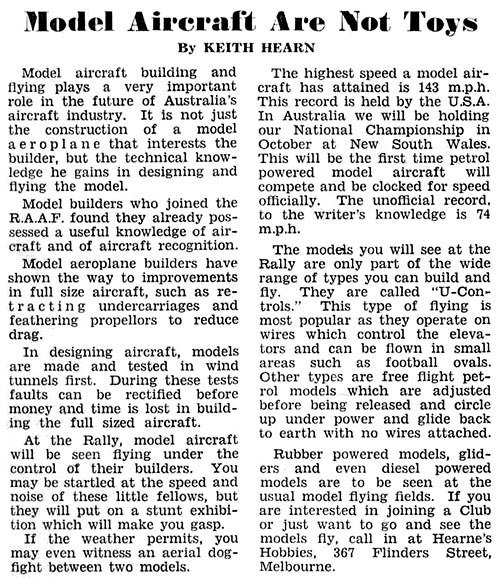 Original c. late 1948
The Mann Monoplane No. 31, 1911
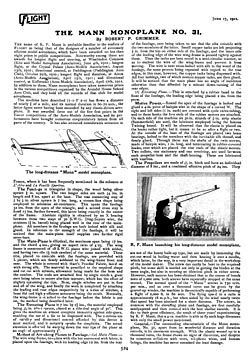 The Mann Monoplane No. 31 Flight, June 17, 1911 download a 1000pixel image
Though we cannot supply plans for the Mann monoplane, plans are available for a very similar model - The Butler Twin Pusher, 1913
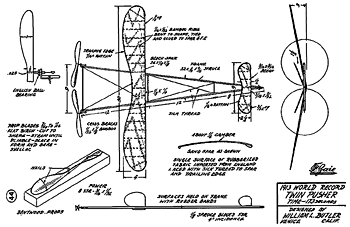 The Butler Twin Pusher, 1913
download a 1/6rd scale plan (1 x vertical A4 page) of Butler's Twin Pusher, 1913 Source : Dannysoar's Twin Pushers and Other Free Flight Oddities
Matt writes (to David Dodge) ...I've been meaning to build a twin pusher since the pages were first published...I finally got around to it. Here are the pictures & specs. As the 'Croc Hunter' Steve Erwin would say "what a little beauty !"
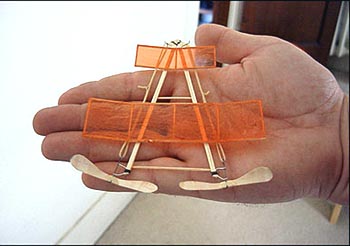
Matt Keveney's 'Mini' Twin Pusher, c.2000
Matt
Reproduced from an article written by Alwyn Greenbagh for the Spring 1979 edition of Windsock. Comments in parentheses and italics are by the current editor. Wide interest in aviation really started when the Wright Brothers brought their `Model A' flier to Europe in 1908 to fly before a very critical audience at Hunaudieres near Le Mans on August 8. It was subsequently to make many more flights in France well into 1909. Two events more than any others popularised the aeroplane as a practical vehicle and these were Beriot's crossing of the English Channel in July and the air meeting at Reims in August 1909. From about 1909 some of the airminded started to make models of the aircraft of the day but these models did not fly well. This led to specific designs for model aircraft and the `T' frame and `A' frame pushers were the most effective types developed. The development of model aircraft followed that of their full size counterparts and the tractor configuration emerged. One of the earliest model tractor monoplanes was built by Mr Smallcombe (Club President) and this model has been preserved and was still air worthy 65 years later (this refers to 1979, does anyone know if this model still exists?). Model aviation had become quite prolific and its interests were controlled by the Kite and Model Aeroplane Association and even in 1914 trophies such as the Farrow Shield, Sir John Shelly Cup, Pilcher Cup and the Gamage Cup were competed for; the same trophies are still competed for today. In addition to these trophies Sir Charles Wakefield had already presented a cup for rubber-driven model biplanes. After the first World War, interest in model aviation greatly increased. The Kite and Model Aeroplane Association declined and in 1920 the London Aeromodels Association was formed. This association changed its name in 1922 and became the Society of Model Aeronautical Engineers. Popular venues for the flying of model aircraft during the 1920's were Wimbledon Common, Sudbury Heights and Parliament Hill Fields. Prominent personalities included F. deP. Green, B. K. Johnson, C. A. Ripon, A. F. Houlberg and R. N. Bullock. Sir Sefton Brancken was the President of the S.M.A.E. The best model shops mere those of A. E. Jones in New Oxford Street, London, and D. A. Pavely in Replingham Road SW19. In 1927 Lord Wakefield presented the "Wakefield" International Cup to the S.M.A.E. and the first contest was held the following year. Also in 1927 an organisation called "The Model Aircraft Club" was founded and had divisions known as "Wings" in various parts of the country. Each Wing had a "Wing Commander" and the Secretary of the whole of the Club was Mr. A. E. Jones. The first official announcement of organised model aviation activity in the Reading area was a notice in the Model Engineer issue of May 21st 1931 inviting all those interested "to communicate with W. A. Smallcombe Esq., B.Sc., curator, Museum and Art Gallery, Reading, who is organising a Wing of T.M.A.C in this area". A similar notice also appeared in the Reading Mercury on or about May 28th 1931 inviting enthusiasts to a meeting at the Y.M.C.A, Friar Street at 6:30 p.m. on Wednesday 3rd June. The notice also advised of the first field day on the Woodley Aerodrome (by kind permission of Messrs Powis). So was formed the l4th (Reading) Wing of T.M.A.C with W. A. Smallcombe as the Wing Commander. The inaugural flying meeting of the l4th Wing was held at Woodley on Saturday July 25th. 1931 and was described in the Model Engineer of August 6th. as follows: "Saturday, July 25 dawned and continued as a real soaker. Storm after storm, gusty wind and cloud were the order of the day. Despite these conditions, about twenty Reading members and friends, together with eighteen members of T.M.A.C. from headquarters, and the lst, 3rd, 4th and l2th. Wings braved the elements and turned up at the aerodrome. Mr. Jones and Mr. Yeomans were present and gave cheer, encouragement and helpful criticism. Mr. Trevithick, of the lst Wing, brought his compressed-air model and so did Mr Mann of the l4th, but neither were able to chance a flight, although both were in flying trim. Wing-Commander Knight flaw several beautiful little machines of the Knight class, obtaining a number of good flights. Mr Selwin Perry was flying a nicely finished red and white 'bus, while Mr Bennet of the 4th Wing obtained some spectacular flights with his beautiful little scale biplane. Wing-Commander Smallcombe flew a high-wing geared 'bus until a nose-dive into a puddle ended its useful existence. A photograph of the l4th Wing appeared in the August 20th issue of the Model Engineer. A Workshop facility had been arranged for members, the Y.M.C.A, Friar Street kindly permitting them to use their workshops on alternate Wednesday evenings. Flying meetings were held at Woodley en the third Saturday of every month. Nationally, the most significant event was the Wakefield Cup Contest, won in 1931 by Joe Ehrhardt of the U.S.A. He had won it in 1930 with a balsa and tissue model and his second win ensured that all contest models from then on needed to be of balsa structure covered with tissue. The 1932 Wakefield contest was declared void, there being infringement of the rules and the 1933 contest was won by J. W. Kenworthy of the Manchester club, with a balsa model the "Conqueror". By 1933, the influence of The Model Aircraft Club was waning and specific model aircraft clubs affiliated to the S.M.A.E were being formed. The S.M.A.E. had been given the mandate from the Royal Aero Club to control all model aviation activity in Britain. The Reading and District Model Aircraft Club was founded in 1933 and a report of the opening meeting at Woodley was given in the Model Engineer of April 27th. 1933. Wr. W. A. Smallcombe was Chairman of the club and Mr A. Gibson the secretary. 1933 saw the demise of the "spruce and silk" model aircraft in favour of the "balsa and tissue" model. This year also saw the advent of the first efficient and light petrol engine for model aviation use - the Brown Junior, of 9 cc capacity, distributed in Britain by Stuart Turner Ltd., of Henley-on-Thames, price £6:12s:6d ( £6.60 approx), complete with ignition coil and condenser. Model aircraft became much more efficient and the contests for the trophies available produced very much higher performances. In 1936, the first British Team to be sent abroad, accompanying their models, was to the Wakefield Cup Contest at Wayne County Airport, Detroit, U.S.A. Prior to this, only the models had been sent abroad and flown by proxy. A.Greenbalgh of the Lancashire Model Aircraft Society was the youngest member of this team, he had already won the Farrow Shield for the Lancashire Club in 1934 with a flight of 17 mins. 23 seconds, which was also a British record. World Was Two interrupted the progress of model aviation in Britain. Power-driven models were prohibited due to security reasons and new material became scarce. During the war, the value of building model aircraft and their flying was quickly realised by the Cadet organisations and this caused some materials to be released. Many a long dark evening was spent by clubs in arranging Round-the Pole flying contests for duration speed and for scale models. Their flying grounds had been dotted with vertical poles to stop or damage enemy gliders or paratroops should they arrive. This R.T.P flying gave rise to outdoor R.T.P flying which developed into control-line flying. After the war, the small compression-ignition engine had been perfected - it was designed by the French "Micron" company as a prime mover for electrical generators for use by the Resistance Movement, but this type of engine proved to be too noisy for its intended purpose. As an engine for a model aircraft however it proved eminently suitable. Heavy ignition equipment was unnecessary and very small engines were efficient. The latest (1979) development is, of course, the glow-motor. This was invented by Bill Atwood in the U.S.A. when he fitted a plug with a spiral platinum filament into a standard petrol engine, heating the plug by an electric current in order to start the engine. Also during World War Two, the electronics industries had been busy miniaturising components and this has directly led to their successful application to the radio control of models. A further and most important development was that of the transistor which has enabled production of the very sophisticated gear available today. With the advances in model aviation resulting in most efficient aircraft, contest rules have needed revision. No longer is it a requirement for a Wakefield Class model to have a fuselage of a minimum area of cross section, or even an undercarriage. The models are now hand-launched; even the relative weight of rubber is prescribed. For power-driven models the engine running time in contest is very strictly controlled. The Reading and District Model Aircraft Club is included in the list of those affiliated to the S.M.A.E. in the articles of association of the S.M.A.E.Limited, laid down in 1948, the Secretary at that time was H. W. Jackson of Tilehurst. The Reading Club has experienced its ups and downs, much the same as other similar clubs, but is now flourishing and certainly covers every aspect of model aviation. Mr. W. A. Smallcombe is President and his interest spans some 70 years. May both President and Club prosper for many years to come.
Radio ControlNikola Tesla and his 'Teleautomata' Telautomats will be ultimately produced, capable of acting as if possessed of their own intelligence, and their advent will create a revolution.Telautomata http://onlinetools.chipcenter.com/netsim/tesla/tesla2.html - site no longer online
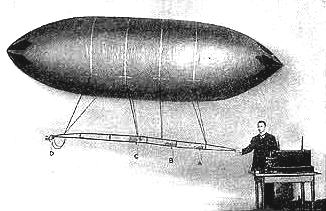 Nikola Tesla with his wireless controlled airship c.1900
The idea of banishing warfare by making it inconceivably horrific was a widely held conceit pretty much until the end of WWI. Even at the time, though, it was less popular with the literary crowd Tesla had insinuated himself with (although his good friend Samuel Clemens encouraged him to continue this work). Moreover, by this time his wild prognostications had caused many former colleagues to openly distance themselves and to belittle his inability to deliver inventions equal to the extravagent claims he made for them. Tesla had reached the zenith of his notoriety and the fall from this state of grace would be long and painful.
On November 8th, 1898, Tesla obtained a patent for the remote control, for which he had applied four months earlier on July 1st. This patent is the basis of contemporary robotics. The site features a video showing a transparent hull, working replica of his wireless remote controlled boat of 1898 [9Mb file]
"...What Tesla did was to demonstrate the possibility of remote control by radio waves. In the artificial lake, the audience saw a six-foot, iron-hulled boat decorated with tiny electric lights. Ever the master showman, Tesla invited the crowd to shout out commands, "Turn left! Turn right! Flash the lights!" In response, Tesla signaled the boat using his wireless transmitter and the boat executed the command. With the Spanish-American War just over, Tesla described how he could easily build a larger boat, arm it with dynamite, and then steer it by remote control toward an enemy ship. Here, one hundred years ago, was a prototype for the Cruise missiles used in the recent wars in Iraq and Kosovo....more
Sample page at right (page 1 of 5 pages of drawings, the remaining eight pages contain the supporting text) You will need to use Stuffit Expander (or similar eg: PKZip) to decompress these pages. Stuffit Expander and PKZip are available free from tucows.com
Chris 540 Can anyone tell me around when RC flight was started? It was flown with escapments correct? Please give me some info! :) Thanks! bob36 : Chris You should try the AMA web site you can get the information you want there. RC_Eflyer : Escapments and the Old Reed Radios, a long time ago, back when names like McCoy and Brown were big names. People actually built planes, oh it was a different time. (Way before my time, I wish I had been around them) --Paul "Theres too many ARF's" rreiss : Experiments started in the late 30's, but really started getting serious after WW II. Almost all early RC planes were converted free-flight planes high wing and BIG fuse. The cabin area was large to hold the receiver and large batteries. The receivers were about 4" wide & 6 to 8" long with radio type tubes. These were the first quarter scale planes out of necessity not just to impress. For multi-channel systems it required one channel for each direction on each surface ie. 8 ch. radio then was our 4 ch. today. My first radio was a Kraft single button Tx. with two esc. That was back in 1959. On the Tx. you pushed the button once for full left rudder -- twice for full right -- three times for a rise in throttle. There was usually only three speeds for the engine. Notice no mention of elevator -- real pilots from back then didn't need no stinkin elevator. The horizontal stab was warped up slightly and used the throttle to change altitude. Sometimes you got enough lift to clear the trees and sometimes not. The worst scenario was when the rubber band to the rudder escapement broke. You then got in your car and the chase was on. After college and getting a real job about 1970, Mexico started producing the EK 3 channel brick radio selling for $180. to $200.00. Had to have it. The next big step was about 1974 when I first saw the EK 8 ch. system -- what a bargain for $500.00 -- sold what I could to get that one. That was all back in a time when you went to the LHS talked with the expert flyer/owner, bought the box of balsa strips and MADE a plane. Wow when solarfilm and monokote made the scene, it was like the beginning of time. Only the old-timers can understand the fun of building a plane in a small room with a tube of Testors or Ambroid glue. Believe me that was better than "you know what". Forgot to mention that when I got started in RC, you had to take a FCC Citizen Band test to be issued your call letters before you were allowed to fly. The FCC was very stingy with who could use THEIR air space. We're all too spoiled now. ChuckN : Interesting trivia - radio controlled airplanes actually pre-date control line. John BucknerMore trivia! One pioneer even more or less succeeded with a remotely controled (not radio controled) large glider by sound. This I think was early thirtys just before the first successful radio systems. This ten footer with a large sound cone in the fuse would actuate the rudder in one direction only. It was pitched off a hill and the pilot would chase after it blasting away with a tank and air horn. Even worked! Now I,am not sure of this fact but I think that pioneer was Jim Walker the inventor of course later of controlline flight. Jim Messer : I saw my first R/C airplane in 1948 at the Plymouth 2nd. International Plane Meet in Detroit. It was flown by Walt Good and his brother Bill. These were the two guys that pioneered R/C. I got my first single channel system in 1957 - a Bramco BCR-3 with three tubes, 1U4, 1U5, and 3V4. Then in 1958 I got a Citizenship 465 single channel - much improved system. Still on escapements. Then came DeBolts servos that replaced the escapements. In 1960 we were flying reeds, Orbit and Citizenship, 12 channel systems with Bonner servos. Then came the Orbit 3+1 analog system - first of the proportionals, as well as the Space Control brick system. In 1963 Bob Dunham built me a 7/14 digital system - very solid - good servos, $500.00. In 1971, I switched to Pro-Line single stick and flew that for 20 years. About 1990 I got a computer radio - Ace Pro-8000 single stick, but that crapped out so in 1995 I got a Futaba 8UAF and you know all about these kind of radios. oldradiogy : Just wanted to add a bit of trivia to the question of when RC flight really started. Bruce Fredrick : Radio Control actually started in 1898 when Nikola Tesla invented and patented the radio receiver and transmitter. He demonstrated true radio control using a multi-channel radio system to control a submarine, which he also patented the same year. To many peoples surprise, this predates Marconi's patent by several years. In 1943, the US Supreme Court declared Marconi's patent on the invention of radio invalid, giving the invention of radio back to Nikola Tesla as per his 1898 patents. Marconi, it seems, had attended one of Tesla's seminars on Radio wave transmission prior to Marconi filing his patent in 1904. And, sure enough, when the patent records were checked, there were Tesla's earlier patents on tuned radio circuits and the ability to use those circuits for transmitting voice, data, and remotely controlling devices. The circuits that Tesla used in his original remote controlled submarine are still in use in modern radio transmitters and receivers used in R/C today. skylane42 : But the first RC airplane was flown by the Good Brothers in Kalamazoo Michigan where the attended Kalamazoo College. oldradiogy : Thanks for the reminder that the Goods were the first to fly a "hobby" RC airplane, but the rights to the first airplane flown by RC appears to go to a Navy N-9 seaplane and its team. The N-9 was flown completely by radio control on September 15, 1924, a full 10 or more years prior to the first Hobby RC plane. But you are right on target that the Goods were the first in the US. Were they also the first in the World? Seems there was some stuff going on over in England around that time. Haven't found much info on the history of RC in England. Some early magazine articles that I recently received from the AMA seem to point toward the Hobbyists here in the United States leading the charge in the RC arena. EASYTIGER : Yep, that was Jim Walker, with the sound-controlled sailplane. It worked! One night, when he was walking around the neighborhood with a bunch of horns and noisemakers, testing the system, the local cop showed up, responding to the neighbor's noise complaints. Jim was such a smooth guy...a few minutes later, he got the cop firing his pistol into the air to help test the system... There were definitely successful "hobbyist" RC flights in the thirties, and it does predate control line. The good brothers deserve the credit for really developing practical, useable, consistent systems. But RC aircraft date all the way back to the teens. The RAF used RC target drones during WWI. MinnFlyer : For those of you who are not familiar with escapements, here's a basic idea of how they worked. Look at the figure below.
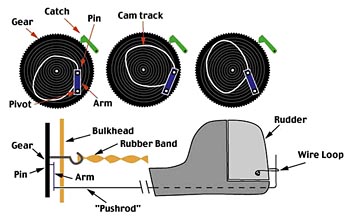 Typical R/C Escapement System download a 750pixel image
When you let go of the button, the gear rotated back to it's original position (having to go past the left rudder position first) When you wanted LEFT rudder, you clicked the button twice (similar to the way we double click a mouse button these days) The escapement would bypass the first position and stop at the second, until you released the button again. So, if you gave one click, you got right rudder for as long as you held the button. When you let go of the button, you got momentary left rudder, then neutral. If you gave 2 clicks, you got momentary right rudder, then the rudder held in the left position till you released. And just think, now days, some people complain because they don't have exponential or flaperons! LOL rreiss : Mike: That was good image to attach. My escapements had 2 and 3 notch positions on the wheel for the pin stop. One thing I forgot on my earlier post was that not only did you fight the plane but you had to try to keep track of how many times you clicked the escapements in flight so you wouldn't run out of windings. If you put 50/60 cranks on the band then you tried not to go over 40 movements of the surfaces to save enough rubber power in reserve for landing. Most of the time there was plenty left when we picked up the pieces.
by John Worth, April 2002 The use of radio control for hobby-type model aircraft began in the mid-1930s. Twin brothers from Michigan, Walt and Bill Good, built and successfully flew their own-design, gasoline-engine-powered RC model, which they called "the Guff." In addition to building the model, they also hand-made their own radio-control equipment for it. Bill was the brother who had the electronics know-how, and Walt was the craftsman with model-aircraft construction skills. Their Guff still exists and has been on display for many years in the Smithsonian's Air and Space Museum in Washington, D.C. Bill died last year, but Walt lives in Florida with his wife, Joyce, and still flies RC models. At the 1937 National Model Airplane Championships in Detroit, hosted by the Academy of Model Aeronautics (AMA), the first known competition for radio-control model aircraft was held; there were six entries. The winner was Chester "Chet" Lanzo of Cleveland, OH. At that time, entrants had merely to demonstrate that their models could take off from the ground, fly upwind, turn around, and then land near the takeoff point. Except for when the U.S. was involved in WW II (1942 through 1945), RC continued to be part of the National Model Airplane Championships from that first event in 1937 until the present. The Good brothers won the event three times. Their radio equipment was among the first to be marketed; under the name of Beacon Electronics, it was produced by Harry Geyer in Pittsburgh. Another RC pioneer was the late Jim Walker of Oregon, who won the national RC event in 1946. Jim was one of the originators of control-line model aircraft, and he went on to become one of the most prominent model-aircraft manufacturers in the world. Jim's commercial success wasn't from RC products, however; he produced control-line model kits, ready-to-fly gliders and rubber-powered models. In those early years, RC model-aircraft operators had to have ham radio licenses issued by the Federal Communications Commission (FCC), and this greatly restricted the number of modelers who could legally fly RC models. Even so, RC event entries at the "Nats" increased from 31 in 1949 to nearly 300 in 1958. Although the model industry was greatly interested in the potential of RC activity, it wasn't considered a viable market because of the legal restrictions. In 1947, I built and flew my first RC model, and the construction plan for it was published in the July 1948 issue of Air Trails magazine. The model was built as a demonstrator for the then new line of Aerotrol RC equipment designed by Ed Lorenz (who now lives in Florida) and produced by the Aero-Spark Co. of Kingston, NY. Up to then, the smallest and lightest RC "set" available, Aerotrol made it possible to use much smaller RC model planes-planes with 4-foot wingspans instead of the more typical 8 or 12 feet. Although it showed the potential of RC models, it would not become popular unless many more modelers could qualify to operate the radio systems. When I was elected president of the AMA in 1963, Walt Good, Chet Lanzo and I led an effort to create and promote a group to lobby the FCC on behalf of model fliers. Our goal was to persuade them to ease the restrictions on who could operate RC equipment. That group was (and still is) known as the AMA RC Frequency Committee, and its first chairman was Walt Good. At first, because the AMA had limited funding, the committee's operation was aided by donations from AMA members. Later, as the committee's work found favor with the FCC and the AMA began to grow (from 20,000 members in 1963 to 150,000 when I retired in 1991), the organization's budget-with financial support from the modeling industry-funded the committee effort and enabled the AMA to retain its own FCC counsel (a former FCC commissioner). From the '60s through the '90s, the FCC gradually provided more license-free frequencies (channels) for RC model use, initially in the citizens band. Eventually, the Commission granted modelers a large group of RC channels for their own use, including 50 for model aircraft and 30 for model car and boat use that we enjoy today. RC activities have since come to dominate all of modeling. For many years at the National Model Airplane Championships, for example, RC entries have typically greatly exceeded all other types of entries combined (control line, free flight, indoor, etc.). Besides the national competitions, there are now more than a thousand local and regional RC events annually. There are also over 2,500 AMA chartered clubs (compared with about 100 in the early 1960s), and the vast majority of them are RC oriented. Furthermore, most of the RC club activities are now organized to encourage fly-for-fun rather than competition, so the scope of activity is much larger than it would be if based on competition alone. With the growth of all this activity, there is obviously now a tremendous market for commercial products. As this market expands, so does the AMA, and I think that this presents a "chicken-or-egg" conundrum: the AMA's efforts with the FCC provided the initial means to create a market for RC products, and now, the industry is producing more and more products to attract new customers.
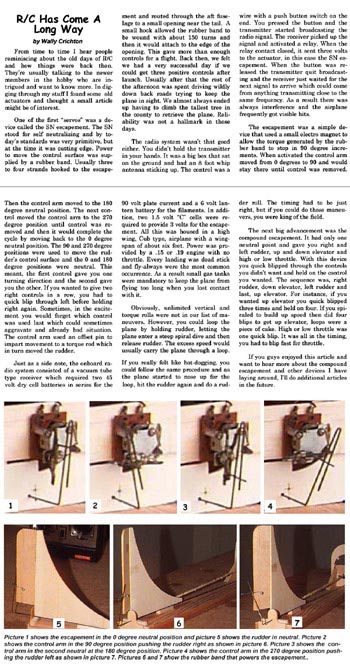 R/C has come a long way download a 3x view
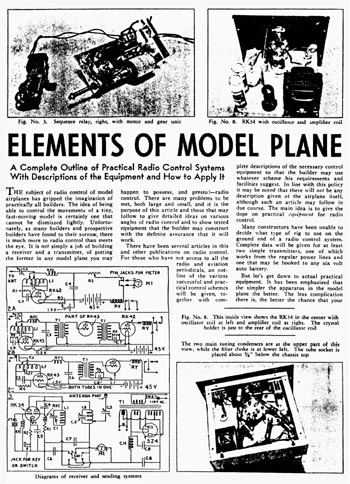 Elements of Model Radio Control, p1
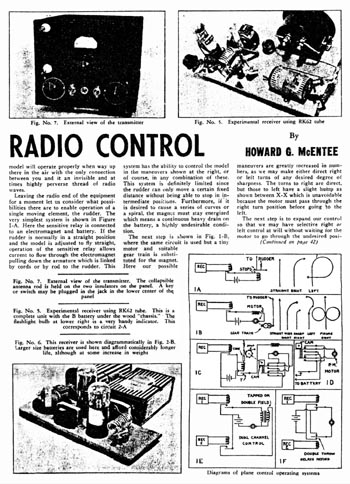 Elements of Model Radio Control, p2
|
© Copyright 1999-2005 CTIE - All Rights Reserved - Caution |
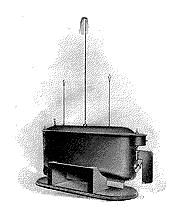 Well before the race for wireless telegraphy and as far back as 1893 in St. Nikola Tesla demonstrated remote control of objects by wireless. This was two full years before Marconi began his experiments. His demonstrations of remote control climaxed in an exhibition in 1898 at Madison Square Garden in which Tesla caused a small boat (right) to obey commands from the audience. Of course, it was Tesla interpreting the verbal requests and sending appropriate frequencies to tuned circuits in the miniature ship, but to the audience it was magic.
Well before the race for wireless telegraphy and as far back as 1893 in St. Nikola Tesla demonstrated remote control of objects by wireless. This was two full years before Marconi began his experiments. His demonstrations of remote control climaxed in an exhibition in 1898 at Madison Square Garden in which Tesla caused a small boat (right) to obey commands from the audience. Of course, it was Tesla interpreting the verbal requests and sending appropriate frequencies to tuned circuits in the miniature ship, but to the audience it was magic.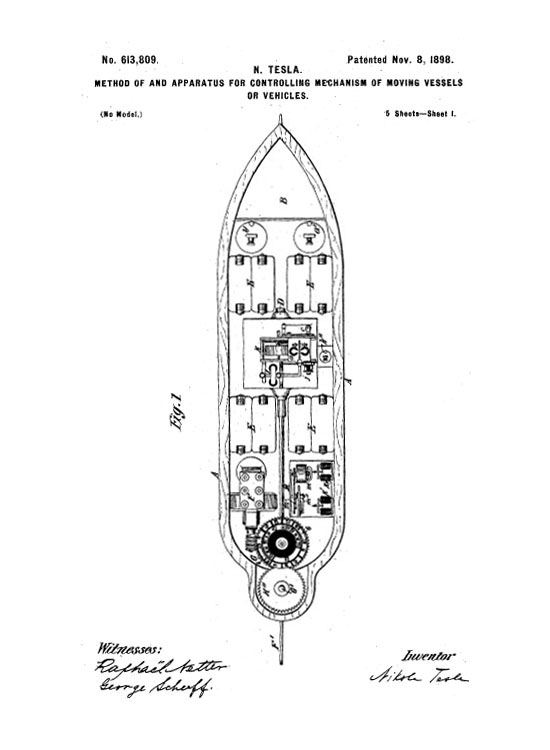 You may wish to download the
You may wish to download the